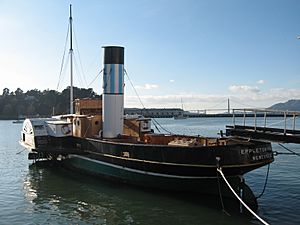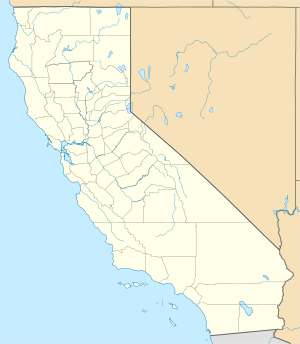Eppleton Hall (1914) facts for kids
class="infobox " style="float: right; clear: right; width: 315px; border-spacing: 2px; text-align: left; font-size: 90%;" |+Eppleton Hall
| colspan="2" style="text-align: center; font-size: 90%; line-height: 1.5em;" | 
|}
The Eppleton Hall is a special paddlewheel tugboat built in England in 1914. It's the only complete paddle tug left that was built in the River Tyne area. It's also one of only two British-built paddle tugs still around. Today, you can find it preserved at the San Francisco Maritime National Historical Park in San Francisco, California.
Contents
| History | |
|---|---|
| Owner |
|
| Port of registry |
|
| Builder | Hepple and Company, South Shields |
| Yard number | 632 |
| Completed | 1914 |
| In service | 1914-1967 |
| Status | Museum ship at San Francisco, California |
| General characteristics | |
| Type | Tugboat |
| Tonnage | 166 gross register tons (GRT) |
| Length | 100.5 ft (30.6 m) |
| Beam | 21.1 ft (6.4 m) |
| Depth of hold | 10.8 ft (3.3 m) |
| Installed power | 500 ihp (370 kW) |
| Propulsion | steam side-lever engines |
| Speed | 10 knots (19 km/h; 12 mph) |
|
Eppleton Hall
|
|
|
U.S. Historic district
Contributing property |
|
| Location | Fort Mason, Bld. 201, San Francisco, California |
| Part of | San Francisco Maritime National Historic Site (ID01000281) |
| Added to NRHP | June 27, 1988 |
History of the Eppleton Hall
The Eppleton Hall was built in 1914 by Hepple and Company in South Shields, England. It was made for the Lambton and Hetton Collieries Ltd. The tugboat was named after a house near Penshaw that belonged to the Hetton Coal Company.
What the Tugboat Did
The Eppleton Hall was designed to pull large coal ships from the sea to the docks. It mostly worked in the River Wear and around the River Tyne. For sailing ships, this saved a lot of time. For bigger steam and motor vessels, it helped them save money on navigation and pilotage (guide) costs. The tugboat also helped new ships get out to the North Sea after they were built.
How the Eppleton Hall Worked
The Eppleton Hall is one of the last of its kind. It was a steam-powered paddle tug. These types of tugs started with the "Tyne Steam Boat" in 1814. The Eppleton Hall had two special side-lever engines. These engines were also built by Hepple & Company and produced 500 horsepower.
The tugboat could travel at a speed of 10 knots. Its engines could work separately, which made the tugboat very easy to steer. It could even turn around in its own length!
Changes Over the Years
From 1914, the Eppleton Hall was operated by Lambton & Hetton Collieries Ltd. In 1924, this company joined with Joicey Collieries. In 1945, the tugboat business was sold to France, Fenwick Tyne and Wear Ltd. After some repairs, the Eppleton Hall worked in Sunderland on the River Wear until 1964.
In 1952, the tugboat was changed a bit so it could carry passengers. This allowed it to transport officials from new ships after their sea trials. In 1964, France, Fenwick Tyne & Wear sold their last paddle tugs, including the Eppleton Hall. It was then sold to the Seaham Harbour Dock Company.
Saved from the Scrapyard
In 1967, the Eppleton Hall was sold to a company that breaks up old ships. It was left on a mud bank in Dunston. Parts of its wooden back deck and inside were even burned as part of the scrapping process. The tugboat stayed there for two years, damaged and rusty.
News about another similar tug, the Reliant, being sold reached Karl Kortum. He was the director of the San Francisco Maritime Museum. Kortum told a museum trustee named Scott Newhall. Newhall then went to England to try and buy the Reliant.
However, the British National Maritime Museum also wanted the Reliant. They planned to take its engines and paddle wheel for display. After some discussions, Newhall decided to buy the damaged Eppleton Hall instead. He wanted to fix it up and bring it to San Francisco.
The Big Journey to San Francisco
The Eppleton Hall was rebuilt in 1969 at Bill Quay, near Hebburn. It was changed so it could cross the Atlantic Ocean on its own power. This meant adding modern navigation tools, a radio, an enclosed wheelhouse, and changing it from burning coal to using diesel fuel.
On September 18, 1969, the tugboat began its long journey to San Francisco. It sailed through the Panama Canal. Six months and nine days later, in late March 1970, it finally passed under the Golden Gate Bridge.
Scott Newhall later wrote a book called The Eppleton Hall. It tells the amazing story of finding and fixing the ship. It also describes the eleven thousand mile journey from England to San Francisco. The trip had many adventures, like running out of fuel in the Bay of Biscay and rescuing a fishing boat.
In 1979, Karl Kortum gave the Eppleton Hall to the National Park Service. Today, it is docked at Hyde Street Pier in San Francisco. It has been restored to look like it did in 1946, after its repairs for France Fenwick, Tyne and Wear Ltd.
The Eppleton Hall Today
The Eppleton Hall is a museum ship. You can see it from Hyde Street Pier, but you can't go inside. This is because it doesn't qualify for grants given to ships built in the US. Even so, it is in great condition.
Another similar paddle tug, the John H Amos, is waiting for repairs in Chatham, England. The Reliant, the tugboat that was originally wanted, was taken apart by the National Maritime Museum. Only one engine and part of a paddle wheel are still on display.
Media
The Eppleton Hall has even inspired characters in TV shows!
- In the TV show TUGS, the character O.J. is based on the Eppleton Hall.
- The boat Lakesider III in Thomas and Friends was also based on the Eppleton Hall.


